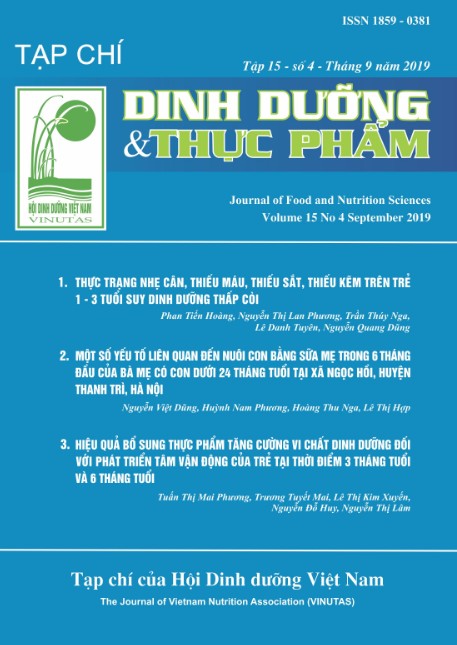UNDERWEIGHT, ANEMIA, IRON DEFICIENCY, AND ZINC DEFICIENCY AMONG 1-3 YEAR OLD STUNTED CHILDREN
Main Article Content
Abstract
Objective: To describe current anemia status, iron deficiency, zinc deficiency and
prevalence of underweight, wasting in stunted children. Methods: 340 stunted children (191 boys and 149 girls), aged 1-3 years old from 12 communes of 3 districts
of Ha Nam, Vinh Phuc, Phu Tho provinces were selected in the study. Body weight,
height, skinfold thickness (including biceps, triceps, subscapular and supra-iliac skinfold thicknesses on the right side of the body) were collected. Skinfold thicknesses were used to calculate percentage body fat. Venous blood (3 ml) was collected to quantify the concentration of Hb, serum ferritin and zinc concentration. Anemia was defined
when Hb concentration was less than 110 g/L, iron deficiency was defined when serum
Ferritin concentration was less than 30 μg/L, zinc deficiency was defined when serum
zinc concentration was less than 9.9 μmol/L. Results: The lowest prevalence of anemia
was observed in boys aged 36-47 months old: 18.4%, and the highest prevalence of
anemia was observed in boys aged 12-23 months old: 54.2%. The lowest prevalence of
iron deficiency was in girls aged 36-47 months old: 41.2%, and the highest prevalence
of iron deficiency was in boys aged 12-23 months old: 87.5%; prevalence of zinc deficiency ranged from 60.8 to 68.1%. The prevalence of underweight among 12-23 month
old boys was 43% and among 36-47 month old boys was 67.4%, none of the study
subjects were overweight or obese. Conclusion: In stunted children aged 1-3 years old,
the prevalence of anemia, iron deficiency and zinc deficiency, underweight were high.
It is necessary to undertake the nutrition intervention to improve the micronutrient and
nutritional status of this group.
Keywords
Children 1-3 years old, stuntinh, underweight, anemia, zinc deficiency, ion deficiency


